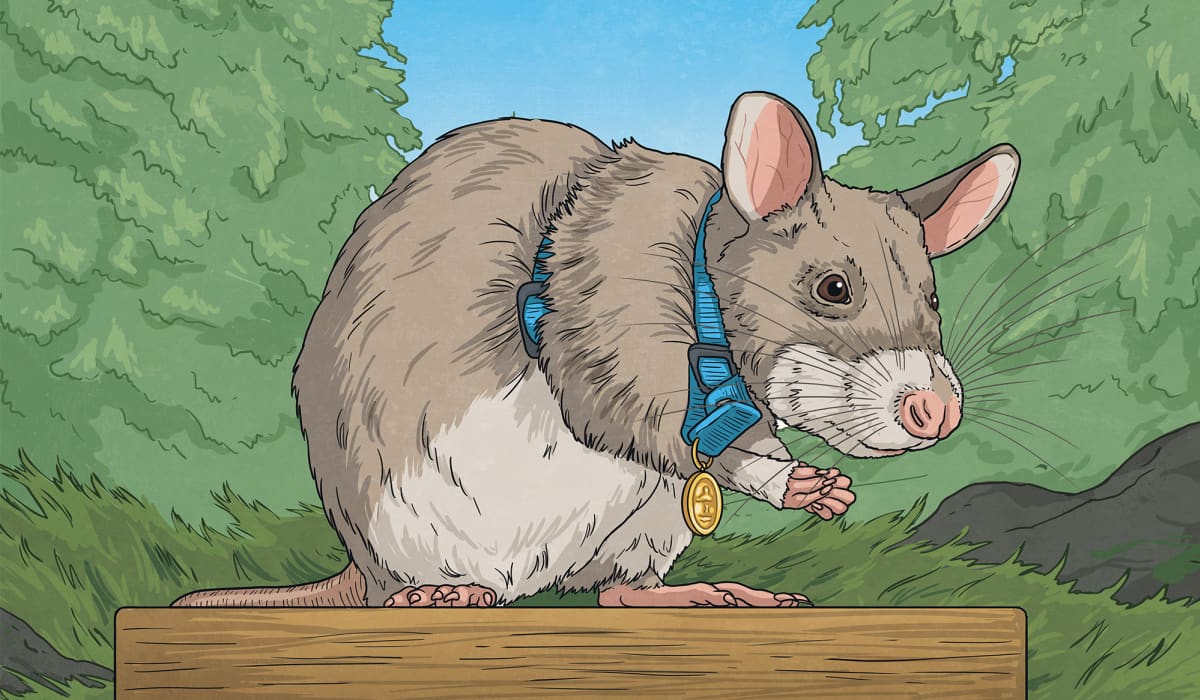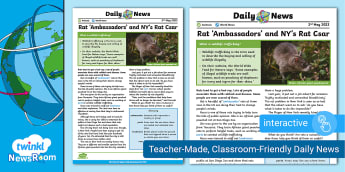
What is a PDSA medal? PDSA medals are given to animals which have shown bravery and dedication to their duty. Other animals to have received medals for their bravery include dogs, horses, pigeons and even a cat.
How do you feel about rats? Well, A rat named Magawa has become the first rat in history to receive an award from the animal charity PDSA for its heroic work.
Magawa, whose official title is HeroRAT, received the PDSA’s Gold Medal. This medal is awarded to civilian animals who show incredible acts of dedication and bravery.
Only 30 animals have ever received a Gold Medal. However, all of the other Gold Medals have been awarded to dogs!
So, what makes Magawa the HeroRAT so special? He is one of many trained HeroRATs. They work in Cambodia where they use their highly-trained sense of smell to sniff out landmines.
According to APOPO, a charity that works to remove landmines in Cambodia using rats, 59 countries suffer as a result of landmines from past wars. They affect the lives of over 60 million people worldwide.
Magawa is a giant African pouched rat. He is bigger than a pet rat but still very light. This allows him to walk across landmines without setting them off.
Christophe Cox, CEO of APOPO said, “we use clicker training to teach rats like Magawa to scratch at the ground above a landmine”.
So far, Magawa has sniffed out 39 landmines and 28 unexploded devices above ground. He has covered a large area of land - approximately the size of 20 football pitches!
This means that people who live in these areas are able to use the land. Land which has been checked can be used as farmland to grow crops.
PDSA director general, Jan McLoughlin, said, “HeroRAT Magawa’s work directly saves and changes the lives of men, women and children who are impacted by these landmines. Every discovery he makes reduces the risk of injury or death for local people”.
It just goes to show that heroes come in all shapes and sizes!
Related News Articles
- Max the Miracle Dog Receives PDSA Award.
- Sperm Whales may have Shared Ideas to Avoid Humans.
- World’s Oldest Bird Hatches Chick.
Want to learn more about HeroRATs?
Here we shall explore some of the common questions and interesting facts surrounding Magawa the HeroRAT and HeroRATs more generally.
What kind of rat is Magawa the HeroRAT?
Giant African Pouched Rat
Magawa the HeroRAT is a giant African pouched rat. This species is perfect for detecting landmines as they are larger than the average pet rat, but light enough to avoid setting off landmines.
Facts about the Giant African Pouched Rat
- This species of rat can grow up to around 92 cm long.
- Once fully grown, around half of the rat’s length consists of its tail.
- Their tails are completely hairless.
- They weigh between 1 and 1.4 kilograms, which means that they are easy to transport to areas with landmines, and will not set them off while trying to detect them, as a landmine needs around 5 kilograms of weight above it to explode.
- Like hamsters and squirrels, they have giant cheek pouches.
- These pouches have evolved so that they can fill them up with nuts to store underground for a later date.
- There are two kinds of the giant African pouched rat- the Cricetomys emini and the Cricetomys gambianus. It’s the latter that get involved with humanitarian work.
- They are indigenous to sub-Saharan Africa, which means that they already have lots of adaptations. This makes them able to work comfortably in hot conditions, which is where landline detection is carried out.
- Once trained, they are very efficient workers.
- They can easily ignore the debris left behind on the land such as scrap metal, nuts, and bolts.
- While ignoring these objects, the rats can successfully find landmines and save lives.
- One rat working alone can check an area the size of a tennis court in around 20 minutes.
- To put this efficiency into perspective, if a human technician with a minesweeper (an aircraft used to detect landmines) was to check a patch of land of this size, it would take around four days.
How long does it take to train a HeroRAT?
To train a HeroRAT, it can take up to nine months. There are a few stages to this, which we shall explore below.
Stage 1: Breeding
The African giant pouched rats are bred strategically to maximise the chances of producing successful landmine or tuberculosis detectors. With this is mind, they breed the most talented detectors to increase the likelihood of having well-performing pups. The pups have three weeks alone with their mothers before being trained for landmine or tuberculosis detection.
Stage 2: Socialization
This stage aims to help the pups get used to the world around them. So, the handlers take them away from their mothers and get them used to the views, noises, and smells the world has to offer. This part of the process helps the HeroRATs (like Magawa the HeroRAT), get used to the area that they will be training in, and to get to know their handlers.
Stage 3: Clicker Training
At around 10 weeks old, the rats are trained to associate a clicker sound with receiving food. This helps to set up their reward system and the motivation to carry out tasks for food.
Stage 4: Discrimination Training
At this stage, the rats are taught to discriminate (tell the difference between) the target scent, such as the smell of an explosive or tuberculosis, and everyday smells. This is the last and most important stage of the process, as it is here that the rats will learn to detect the smell of either landmines or tuberculosis. Throughout this stage, the rats are slowly given a weaker scent to find, which heightens their ability to detect the smells from further distances or different strengths.
HeroRATs and Tuberculosis
Tuberculosis is a deadly disease that is easily spread between people. Sometimes the tests that doctors carry out do not detect it successfully. That’s why HeroRATs have been trained to detect it.
The HeroRATs can test around 100 samples per day, whereas traditional medical methods can only test around 40, and are much more expensive. So far, nearly 20,000 tuberculosis cases have been detected, with over 700,000 samples tested, and nearly 160,000 tuberculosis cases halted.
How long have HeroRATs been detecting landmines for?
Bart Weetjens from Belgium founded APOPO, a non-profit organisation that trains animals to detect landmines and tuberculosis. Bart had pet rats as a child and would train them to track down hidden objects for rewards. It occurred to him as an adult that they could be used to find explosives in the ground.
APOPO specifically makes use of the giant African pouched rat because of its amazing sense of smell, perfect weight, and adaptations to warmer climates.
The Belgian government saw that there could be a huge benefit to using rats to detect landmines, so they gave the organisation a grant. This helped it to expand, and to later train rats to detect tuberculosis.
So far, APOPO’s projects have destroyed over 20,000 landmines, nearly 89,000 UXOs (unexploded military devices), and nearly 32,000 small arms (weapons).
Don't miss...
- Max the Miracle Dog Reading Comprehension.
- Sperm Whales Reading Comprehension.
- Albatross Reading Comprehension.
Related Resources
Magawa the HeroRAT reading comprehension pack
This news story also comes with a handy reading comprehension pack to help you assess your learners’ understanding of the work of Magawa the HeroRAT. You’ll find a selection of SATs-based reading comprehension questions, a 60-second read activity, and extension tasks. A handy guidance document comes with this to help you get the most out of each resource.
More News Stories
- World’s Highest Living Mammal is a Volcanic Mouse.
- Roman Colosseum Gets New Floor.
- Self-Driving Cars to be on the Roads in 2021.
The above video may be from a third-party source. We accept no responsibility for any videos from third-party sources. Please let us know if the video is no longer working.

 Home
Home  Membership
Membership  Customer Support
Customer Support  Create
Create  Blog
Blog 


